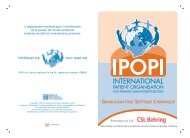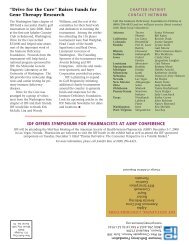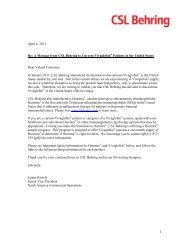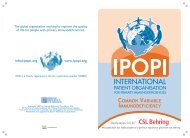IDF Patient & Family Handbook for Primary Immunodeficiency ... - IDFA
IDF Patient & Family Handbook for Primary Immunodeficiency ... - IDFA
IDF Patient & Family Handbook for Primary Immunodeficiency ... - IDFA
You also want an ePaper? Increase the reach of your titles
YUMPU automatically turns print PDFs into web optimized ePapers that Google loves.
Hyper IgE Syndrome<br />
61<br />
Inheritance of Hyper IgE Syndrome continued<br />
also have viral infections including Molluscum<br />
contagiosum, Herpes simplex and recurrent<br />
Varicella zoster. No lung cysts occurred in patients<br />
with this <strong>for</strong>m of HIES, although the incidence<br />
of pneumonia was the same, and many died in<br />
childhood with neurological complications.<br />
Treatment of Hyper IgE Syndrome<br />
Skin care and prompt treatment of infections<br />
are the most important elements of HIES<br />
management. Skin colonization precedes<br />
infection. Topical antibacterials and oral antibiotic<br />
treatment are often effective preventive measures.<br />
When eczema is severe, topical moisturizing creams<br />
and limited topical steroids can help achieve healing.<br />
Antiseptic treatments of the skin greatly reduce<br />
the bacterial burden in the skin without leading to<br />
emergence of antibiotic resistant bacteria.<br />
Skin abscesses may require incision and drainage,<br />
but can largely be prevented with continuous oral<br />
antibiotics. The role of prophylactic antibiotics<br />
has not been rigorously investigated, but there is<br />
general consensus in favor of use of antibiotics<br />
against Staphylococcus aureus in HIES.<br />
Candidiasis of the fingernails, mouth or vagina in<br />
HIES rarely disseminates and responds to oral<br />
triazole antifungals, which have been of great benefit<br />
to patients with HIES. Although the over-use<br />
of antibiotics and antifungals is discouraged in<br />
general with “normal“ patients, due to concerns<br />
about selection <strong>for</strong> resistant organisms, the<br />
under-use in HIES leaves this group at risk <strong>for</strong><br />
infections that are debilitating and dangerous.<br />
A remarkable feature of HIES is how well the<br />
patient may feel (and appear) when they have an<br />
infection. For example, even with evidence of a<br />
significant infection on physical examination and<br />
X-ray evidence of pneumonia, an HIES patient<br />
may deny feeling sick and may not see the need<br />
<strong>for</strong> invasive diagnostic testing or prolonged<br />
therapy. Moreover, doctors unfamiliar with HIES<br />
are hesitant to believe that patients who do not<br />
appear very ill, and appear about the same as<br />
usual, are really quite ill.<br />
Finding the organisms causing an infection cannot<br />
be overemphasized. Lung abscesses may require<br />
drainage or resection, but surgery is difficult in<br />
HIES because patients’ remaining lung tissue often<br />
fails to expand to fill the chest cavity. Prolonged<br />
chest tube drainage and intensive IV antibiotic<br />
treatment may be needed. There<strong>for</strong>e, pulmonary<br />
surgery in HIES should not be undertaken lightly,<br />
and ideally it should be per<strong>for</strong>med at a medical<br />
center with experience with the disease.<br />
Following the resolution of acute pneumonias,<br />
pulmonary cysts or cavities <strong>for</strong>m what serve<br />
as a focus <strong>for</strong> colonization with Pseudomonas<br />
aeruginosa, Aspergillus and other fungal species.<br />
These super infections can be a difficult aspect of<br />
HIES. Potential management strategies include<br />
continuous treatment with antifungal drugs and/or,<br />
aerosolised antibiotics.<br />
Although individual case reports have suggested<br />
benefit from interferon, immunoglobulin<br />
replacement therapy, G-CSF or other treatments,<br />
a general role <strong>for</strong> immune reconstitution and/<br />
or immune modulators in HIES is unproven.<br />
It has been previously suggested that since<br />
immunodeficiency is a central part of HIES,<br />
bone marrow transplantation might be curative.<br />
However, in the two instances in which it has<br />
been per<strong>for</strong>med, the results have not been<br />
encouraging enough to recommend bone marrow<br />
transplantation <strong>for</strong> most patients.<br />
Expectations <strong>for</strong> Hyper IgE Syndrome <strong>Patient</strong>s<br />
<strong>Patient</strong>s with HIES require constant vigilance with<br />
regard to infections and chronic lung disease.<br />
With early diagnosis and treatment of infections,<br />
most patients with HIES lead full lives, becoming<br />
productive adults.
















